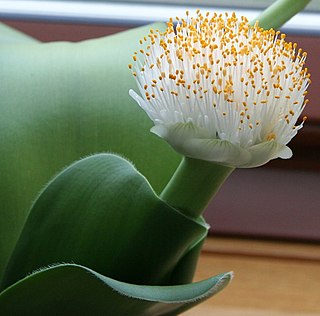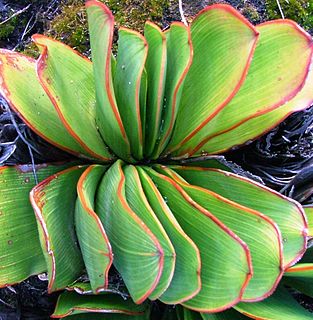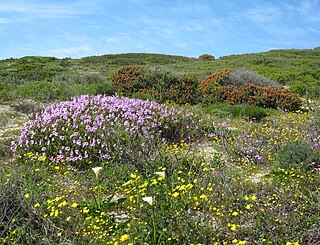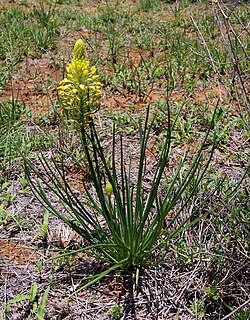
Haemanthus albiflos is a species of flowering plant in the family Amaryllidaceae, native to South Africa. It is sometimes given the English name paintbrush, not to be confused with Castilleja species which also have this name. It is an evergreen bulbous perennial geophyte, prized horticulturally for its unusual appearance and extreme tolerance of neglect. H. albiflos is the only Haemanthus species found in both winter and summer rainfall regions, and has a mainly coastal distribution from the southern Cape through the Eastern Cape to KwaZulu-Natal, showing a preference for cool, shady spots.

Haemanthus is a Southern African genus of flowering plants in the family Amaryllidaceae, subfamily Amaryllidoideae. Members of the genus are known as blood lily and paintbrush lily. There are some 22 known species, native to South Africa, Botswana, Namibia, Lesotho and Swaziland. About 15 species occur in the winter rainfall region of Namaqualand and the Western Cape, the remainder being found in the summer rainfall region, with one species Haemanthus albiflos occurring in both regions.

Haemanthus amarylloides Jacq. is an endemic South African bulbous plant first described in 1804 by Nikolaus Joseph von Jacquin from specimens sent to the Schönbrunn Palace gardens by the collectors Boos and Scholl. Franz Boos was an Austrian botanist who, with Franz Bredemeyer, made up Emperor Joseph II's gardening team. Boos and his assistant Georg Scholl, were collecting Cape plants for the imperial gardens. These collections were transported to Vienna by Nicolas Thomas Baudin, who had been carefully briefed by Boos on the techniques used for keeping plants and animals alive on long ship voyages.

Haemanthus avasmontanus Dinter is a South African bulbous geophyte in the genus Haemanthus. It is known from the type specimens only, which were collected by Kurt Dinter on 12 February 1923 from a single locality in the Auasberge near Tigerfontein on steep, south-facing, mica schist ledges, south-east of Windhoek in central Namibia.. Despite thorough searches by a number of field botanists, no plants have been found since.

Haemanthus coccineus, the blood flower, blood lily or paintbrush lily, is a species of flowering plant in the amaryllis family Amaryllidaceae, native to Southern Africa. Growing to 35 cm (14 in) tall and wide, it is a bulbous perennial with short brown stems surmounted by red flowers, the flowers appearing in spring and summer, before the strap-shaped leaves.

Haemanthus canaliculatus is a South African bulbous geophyte in the genus Haemanthus. It is found only over a small area in the Western Cape between Kleinmond and Rooiels, growing at about 30 m above sea level with an annual rainfall of 650 mm. Its favoured habitat is under dense bush in seasonally inundated shallow depressions, where it usually occurs in clumps. The leaf-bases or tunics of the bulb are thick, fleshy, distichous and loosely separated as in the spread fingers on a hand cf. Haemanthus pubescens. Leaves are from one to four, red-barred at the base, held in a sub-erect position and appear after the flowers. The peduncle is up to 200 mm long with 5-7 spathe valves that are bright red to pink in colour. Fruits are about 20 mm in diameter and reddish. Seeds are shiny and deep red.

Haemanthus carneus is a South African bulbous geophyte in the genus Haemanthus. Despite a fairly wide distribution, it has been collected from only a few scattered sites in the Free State, KwaZulu-Natal and the Eastern Cape near Grahamstown and Somerset East, occurring between 300 m and 1200 m above sea level.

Haemanthus crispus is a South African bulbous geophyte in the genus Haemanthus and occurring in Namaqualand which lies in the winter rainfall region. It is a common species and is found from Steinkopf to the Olifants River, growing from the coastal flats eastwards onto the stony, lower slopes of the first terrace, usually in heavy soils and often in the shade of low succulent shrubs.

Haemanthus dasyphyllus is an endemic South African bulbous geophyte, one of about 20 species in the genus Haemanthus, and is found near Loeriesfontein in Namaqualand.

Haemanthus pubescens is an endemic South African bulbous geophyte in the genus Haemanthus.

Moraea collina is a species of the genus Moraea, in the family Iridaceae. It was formerly known as Homeria collina.

Kumara haemanthifolia is a species of flowering plant in the family Asphodelaceae. It is a rare species of succulent plant, native to a few high, inaccessible mountain peaks in the Fynbos habitat of Western Cape, South Africa.

Cape Flats Dune Strandveld is an endangered vegetation type. This is a unique type of Cape Strandveld that is endemic to the coastal areas around Cape Town, including the Cape Flats.

Protea acaulos, also known as the common ground sugarbush, is a flowering plant found in the southwestern Cape Region, South Africa. It is also simply known as ground protea; in the Afrikaans language it is known as an aardroos.

Bulbine abyssinica is a species of plant in the genus Bulbine, from eastern and southern Africa.

Protea sulphurea, also known as the sulphur sugarbush, is a flowering plant of the genus Protea in the family Proteaceae, which is only known to grow in the wild in the Western Cape province of South Africa. A vernacular name for the plant in the Afrikaans language is heuningkoeksuikerbos.
Protea intonsa, also known as the tufted sugarbush, is a flowering plant of the genus Protea within the family Proteaceae, endemic to South Africa, where it is distributed from the eastern Swartberg and Kammanassie Mountains to the Baviaanskloof mountains. In Afrikaans it is known as klossie-suikerbos.
Protea pudens, also known as the bashful sugarbush, is a low-growing, groundcover-like, flowering shrub in the genus Protea. It is only found growing in the wild in a small area in the Western Cape province of South Africa.

Protea nana, also known as the mountain rose or mountain-rose sugarbush, is a flowering shrub which belongs within the genus Protea.
Protea convexa, also known as large-leaf sugarbush, is a rare flowering shrub in the genus Protea of the family Proteaceae, which is endemic to the southwestern Cape Region of South Africa.



















